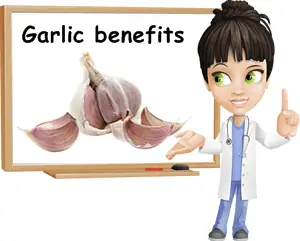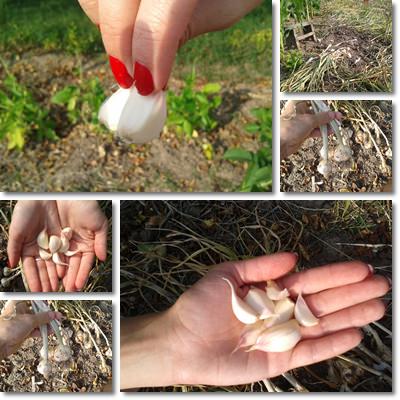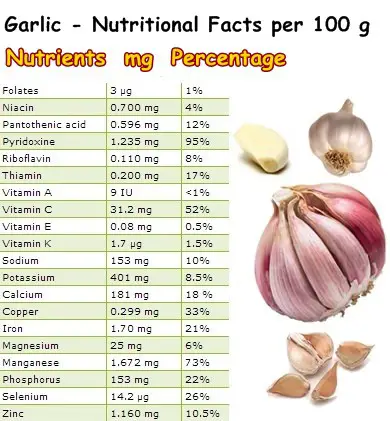Garlic (Allium sativum) is one of the most fascinating bulb plants, a vegetable full of nutrients and antioxidant phytochemicals, highly pungent in flavor and with excellent antimicrobial properties. Garlic is famous for its antibiotic and antibacterial properties and possesses generous amounts of several essential nutrients, notably vitamins C, B1, B5 and B6, copper, calcium, iron, manganese, phosphorus, selenium and zinc. Its sharp flavor is a source of organic sulfur compounds with antioxidant effects and potential benefits for cancer prevention.
Ancient peoples such as the Egyptians, the Greek and the Romans thought garlic was a highly potent medicinal plant and used it to cure everything from parasitic infections to respiratory problems. It was even used as a cure for the plague that broke out in Europe during the Middle Ages.
While not miraculous, naturally-occurring compounds in the flavorful bulb have strong anti-parasitic effects and scientifically proven antibacterial properties.
Studies show eating garlic or taking garlic supplements can result in fewer colds and other respiratory infections and better overall health. Recent studies have also shown that the anthrax bacterium, Bacillus anthracis, for instance, is sensitive to certain natural compounds in the plant species.

What does garlic look like?
Plants have an underground bulb called a garlic head made up of 6-20 kidney-shaped cloves. The bulb is covered with an inedible, thin, white, pink-red or red-purple papery skin. Each individual clove is covered in another layer of inedible, thin papery skin. Depending on the variety, cloves may be white, light brown, pink or red purple, often with patterned streaks of color.
The bulbs are continued above-ground by long, upright, dark green stems, also edible. Garlic actually looks a lot like an onion plant, green onions, scallions or spring onions and leek.
How to tell apart garlic from onions?
The biggest difference between garlic and onions is the smell: garlic will smell like garlic, while onions will smell like onions. A more trained eye might notice that garlic plants are typically smaller than onion plants, with visibly thinner stems. While the young plants are almost indistinguishable in appearance from one another, once they mature and the individual cloves start to develop, the garlic bulb will start looking bumpy rather than acquiring a perfectly round shape.
What does garlic taste and smell like?
Garlic has a strong, sharp smell, crisp texture and a sharp, piquant, hot taste. Raw cloves are especially flavorful, more so when they are freshly crushed or chopped which is when they release sulfur-based compounds responsible for the typical flavor. Powder garlic is usually less pungent than the fresh cloves. Cooked cloves have a soft texture and a sweet taste, without the sharp, piquant flavor of fresh ones. The stems are also edible, raw and cooked, but have a milder taste and flavor. Overall, the younger the plant, the less sharp its taste.

Garlic nutrition facts and benefits
Following a laboratory analysis, Louis Pasteur, the famous French microbiologist, discovered that garlic was a potent natural antimicrobial. His research was taken forward and, after numerous studies, it has been confirmed that the species is indeed a strong natural antibiotic with a wide range of action against various strains of bacteria, viruses and even fungi.
Research conducted at the Wright State University has concluded that garlic is approximately 1% more potent than a traditional antibiotic like penicillin, but test results are limited to in vitro experiments.
There are some researchers that theorize that the blood of a garlic eater can actually kill bacteria. Scientists have conducted experiments to find out whether or not it is more potent than traditional antibiotics and the results have shown that this bulbous, smelly plant can actually prove more efficient even than several broad spectrum antibiotics.
But such properties need to be harnessed and put into concentrated form before substituting antibiotic therapy for garlic eating. If your doctor has prescribed you antibiotics for an infection, it is best you take them accordingly and rely on garlic and good overall nutrition to help build up your immunity in order to avoid future infections.
This way, your body will have a better, stronger, quicker response to future infections, more so when studies show that bacteria do not appear to develop a resistance to garlic.
There are studies which show that more mature and pungent bulbs have a stronger antioxidant and antimicrobial effect than younger, less flavorful plants. Purple or red garlic is also said to have more antioxidants than white varieties and indeed, the reddish-purple streaks of color indicate the presence of anthocyanin antioxidants (see the benefits of red garlic). Furthermore, eating garlic has been shown to help lower high blood pressure and LDL (bad) cholesterol levels, contributing to cardiovascular health.

Overall, the pungent bulbous plant is to be appreciated for its more than generous amounts of essential nutrients. It is particularly rich in vitamin C, hence its immunity-building properties, but should be consumed fresh in order to preserve its vitamin C content. It also contains great amounts of vitamin B6 (pyridoxine), good for digestion and elevated energy levels. Other B vitamins in garlic help with brain and nervous system health and energy metabolism. Copper helps prevent premature hair graying, while manganese is a strong antioxidant. Phosphorus, calcium and magnesium are great for healthy bones, while iron fights anemia.
See also : How Long Does Garlic Sauce Last?
Garlic side effects and contraindications
As the Latin saying goes, Est modus in rebus, it is best to eat garlic in moderation or, better yet, in small amounts. Because it interacts with anticoagulant medication, it is best to avoid it before any major or minor surgery. Garlic supplements in particular are to be avoided because of their concentrated effects and higher risk of bleeding.
The antimicrobial properties of garlic come from a substance called allicin, which is released when the cloves are damaged by cutting, chewing, crushing etc. The pungent compound responsible for the flavor of the vegetable is also a potent antioxidant, but also an irritant for mucous membranes. So, in addition to bad breath, eating too much garlic can cause heartburn, acid reflux and even lesions of the stomach wall that could trigger the onset of gastritis. This is the reason why doctors do not recommend it to people suffering from gastritis or other similar digestive disorders (read more about the best and worst foods for gastritis).
Too much garlic can cause indigestion, nausea, abdominal discomfort and painful stomach cramps. Topical use can cause rashes and skin burns. Inhaling garlic powder irritates the airways and can trigger a laryngospasm or asthma attack in those with allergies and asthma.
And probably the worst of side effects for some people: eating garlic causes bad body smell. One compound that contributes to the pungent flavor as well as some health benefits of the plant is allyl methyl sulfide. This pungent compound travels from the blood to the lungs, causing bad breath. It is also eliminated through the skin, hence the garlic body smell so many people experience after eating the pungent vegetable.
A study released in 2001 suggested that garlic supplements may have dangerous side effects when combined with HIV-AIDS medication, according to the National Institute of Allergies and Infectious Diseases. So talk to your doctor before resorting to any supplements or natural remedies, including eating garlic or taking garlic supplements and especially if you are on some kind of medication.
List of garlic benefits
1) Good for building up immunity against respiratory infections.
2) Has natural antiparasitic effects against intestinal parasites and worms.
3) Anti-inflammatory action thanks to its good vitamin C content.
4) Source of B vitamins for boosting energy and brain health.
5) Contains pyridoxine (vitamin B6) for preventing anemia and dermatitis.
6) Helps the body use selenium for thyroid health and better immunity.
7) Contains selenium for thyroid health (selenium deficiency causes hypothyroidism).
8) Lowers cholesterol and blood pressure.
9) Good for bone density (it contains calcium, magnesium, phosphorus).
10) With 2.1 g of dietary fiber/100 g, it contributes to relieving constipation and has prebiotic benefits.
Lastly, keep in mind that cooked garlic loses all of its vitamin C, but preserves its antimicrobial properties.
